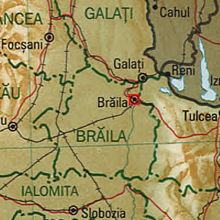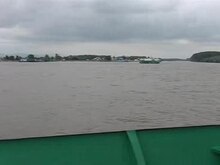Brăila
| Brăila | ||||
|
||||
| Basic data | ||||
|---|---|---|---|---|
| State : |
|
|||
| Historical region : | Great Wallachia | |||
| Circle : | Brăila | |||
| Coordinates : | 45 ° 16 ′ N , 27 ° 58 ′ E | |||
| Time zone : | EET ( UTC +2) | |||
| Height : | 40 m | |||
| Area : | 175 km² | |||
| Residents : | 180,302 (October 20, 2011) | |||
| Population density : | 1,030 inhabitants per km² | |||
| Postal code : | 810xxx | |||
| Telephone code : | (+40) 02 39 | |||
| License plate : | BR | |||
| Structure and administration (as of 2016) | ||||
| Community type : | Municipality | |||
| Mayor : | Viorel-Marian Dragomir ( PSD ) | |||
| Postal address : | Piața Independenței, no. 1 loc. Brăila, RO-810210 |
|||
| Website : | ||||
Brăila ([ brəˈila ]; ) is the capital of the district of the same name and the seat of the south-east planning region in Romania .
Geographical location

Brăila is located in the Wallachia region on the left bank of the lower Danube .
history
The oldest archaeological finds in the area of today's city date from around 4000 BC. Chr.
Between Wallachia and the Ottoman Empire
A first settlement at this point is mentioned around 1350 in the Spanish book Libro de conoscimiento under the name Drinago , Greek documents from the same era mention the names Proilabum or Proilava . The oldest surviving documentary mention comes from the year 1368, when the Wallachian prince Vladislav I allowed merchants from Kronstadt to trade in Brăila.
From 1538 to 1829 the city was ruled by the Turks , including the surrounding area (practically all of today's Brăila district ); under their rule the city was called Ibrail or Ibraila and was a center of Islam in Wallachia . Brăila was also the temporary storage facility for the tributes paid by Wallachia to the Ottoman Empire, which made it a target of attack several times. On February 2, 1470, for example, Ștefan cel Mare attacked the city, sacked it, burned it down and subjugated the troops of the Wallachian prince Radu cel Frumos, who was allied with the Turks .
On June 7, 1828 the city surrendered to the Russian army during the Russo-Turkish War 1828-29 . In the two weeks that followed, all of the forts in North Dobruja were occupied one after the other, including Măcin , Tulcea , Hârşova and Constanța .
Part of Romania
Since 1829 ( Peace of Adrianople 1829 ) Brăila belonged again to Wallachia , from 1859 to Romania. During this time the city became one of the centers of the Bulgarian exile community. The Bulgarian Literary Society (Bulgarian Българско книжовно дружество, from 1911 Bulgarian Academy of Sciences ) was founded here. The port was modernized around 1870; at the same time the city was connected to the railway network through the construction of the Bucharest – Galați – Roman line. In the early 20th century the city reached its heyday as a major trading port. After the Second World War - during communist rule - the planned settlement of industrial companies took place.
In 1968, Brăila was declared a municipality and in 2011 it was the eleventh largest city in Romania.
Modern cityscape
The well-preserved old town of Brăila is located on the left bank of the Danube on a flat plateau. The labyrinth of narrow streets, rustic residential buildings and old Orthodox churches around the central Traiansplatz was largely spared from new buildings, although some of them are in need of renovation. Around the old town with pedestrian zone and city park, semicircular concentric boulevards, which were laid out in the 19th century, close. On city maps, Brăila resembles a huge amphitheater open to the Danube.
On January 15, 2018, the contract to build a bridge over the Danube near Brăila was signed. Once completed, it will be the third largest European bridge of its kind.
population
In 1930 around 68,000 inhabitants were registered in the city, including around 51,500 Romanians , 6,000 Jews , 4,500 Greeks , 1,000 Russians and Hungarians each and 600 Germans .
At the 2002 census , there were 216,292 residents in Brăila, including approx. 210,000 Romanians, 3,500 Russians, 1,600 Roma , 300 Greeks, 160 Turks and 100 Hungarians.
In 2011 the number of the population fell to 180,302. 162,565 of them were Romanians, in 2025 known as Roma, in 1926 as Lipovans , 174 as Greeks, 150 Turks, 45 Hungarians, 35 Macedonians , 34 Italians and 28 each known themselves as Germans and Ukrainians .
Economy and Infrastructure
Brăila has a freight port on the Danube. A ferry runs north of the city center to the right bank of the Danube to Smârdan . This connection is part of the European route 87 . Trains to Galați , Ploieşti and Bucharest run from the train station in Brăila several times a day . Local transport is handled by buses, large taxis and five tram lines. The Brăila tram is the oldest electrically operated tram in Romania; the first line opened in 1901.
Attractions
- The historic city center is a listed building.
- The Sfinții Arhangheli Mihail și Gavril Orthodox Church , built in the 18th century, is a listed building.
- The Armenian Church of Sfânta Maria , built between 1867 and 1871.
- The Bulgarian Church Înălțarea Domnului , built from 1868 to 1882.
- The Roman Catholic Church of Adormirea Maicii Domnului , built in 1855.
- The Protestant Church, built by Romanian Germans in 1885
- The Greek church Buna Vestire , built between 1863 and 1872, is a listed building.
- The Orthodox Church Sfântul Ierarh Nicolae was rebuilt after a fire on December 6, 1860 (according to different information) 1861-1864 or 1863-1865.
- The Orthodox Cathedral Acoperământul Maicii Domnului , built by Lipowaner in 1880.
- The Herș Leib și Netty Schäffer grammar school , built in 1912, is a listed building.
- Memorial house for Panait Istrati
- Remains of the castle (11th - 16th centuries)
- Playhouse
Town twinning
Sister cities of Brăila are:
sons and daughters of the town
- Nicolae Teclu (1838–1916), Romanian chemist and architect
- Hariclea Darclée (1860–1939), Greek-Romanian opera singer
- Constantin von Economo (1876–1931), Greek-Austrian psychiatrist and neurologist
- Markus Sternlieb (1877–1934), Jewish architect in Germany
- Panait Istrati (1884–1935), Romanian writer
- Nicolae C. Ionescu (1890–1940), Romanian philosopher and theologian
- Petre Andrei (1891-1940), Romanian sociologist
- Ana Aslan (1897–1988), Romanian medical doctor and gerontologist
- Andreas Embirikos (1901–1975), Greek poet
- Ilarie Voronca (1903-1946), Jewish-French writer
- Joseph M. Juran (1904–2008), Jewish-American industrial engineer
- Rafael Schächter (1905–1944 / 1945), Czechoslovak pianist, composer and conductor
- Christos Tsaganeas (1906–1982), Greek actor
- Mihail Sebastian (1907–1945), Jewish-Romanian writer
- Ștefan Bălan (1913–1991), Romanian politician (PCR)
- Sony Niculescu (1914–1986), Romanian football player
- Manea Mănescu (1916–2009), Romanian Prime Minister
- Ștefan Filotti (1922–1969), Romanian football player
- Iannis Xenakis (1922–2001), Greco-French composer and architect
- Ștefan Mihăilescu-Brăila (1925–1996), Romanian actor
- Serge Moscovici (1925–2014), Jewish-French social psychologist
- George Grigoriu (1927–1999), Romanian composer, musician and songwriter
- Constantin Toma (1928–2008), Romanian football player
- Johnny Răducanu (1931–2011), Roma jazz musician
- Maria Albuleț (1932–2005), chess player
- Nicolae Rainea (1933-2015), Romanian football referee
- Antigone Kefala (* 1935), Greek-Australian poet
- Calistrat Cuțov (* 1948), Romanian boxer
- Fred Popovici (* 1948), Romanian composer
- Simion Cuțov (1952-1993), Romanian boxer
- Tudorel Stoica (* 1954), Romanian football player
- Nicolae Tilihoi (1956-2018), Romanian football player
- Lică Movilă (* 1961), Romanian football player
- Anișoara Stanciu (* 1962; nee Cușmir ), long jumper
- Dan Dediu (* 1967), Romanian composer
- Mihai Tudose (* 1967), Romanian Prime Minister
- Florian Tudor (* 1973), Romanian rower
- Adelina Gavrilă (* 1978), athlete
- Camelia Potec (* 1982), Romanian swimmer and Olympic champion
- Diana Mocanu (* 1984), Romanian swimmer and Olympic champion
- Anamaria Ioniță (* 1988), athlete
- Alexandru Chipciu (* 1989), Romanian football player
See also
Web links
Individual evidence
- ↑ a b 2011 census in Romania ( MS Excel ; 1.3 MB)
- ↑ Mayoral elections 2016 in Romania ( MS Excel ; 256 kB)
- ↑ a b c History of Brăila on the website of the prefecture ( Memento of the original dated February 4, 2016 in the Internet Archive ) Info: The archive link was inserted automatically and has not yet been checked. Please check the original and archive link according to the instructions and then remove this notice. accessed on September 2, 2013 (Romanian)
- ^ Robert S. Rush and William W. Epley: Partnership for Peace. Consortium of Defense: Multinational Operations, Alliances, and International Military Cooperation Past and Future , Vienna, 2005, p. 14; Roumen Dontchev Daskalov and Tchavdar Marinov: Entangled Histories of the Balkans - Volume One: National Ideologies and Language Policies , 2013, p. 84
- ↑ a b Сборник История русской армии
- ↑ Brăila County Police website, accessed August 14, 2009
- ↑ Information on the city's website ( Memento of the original from July 1, 2017 in the Internet Archive ) Info: The archive link has been inserted automatically and has not yet been checked. Please check the original and archive link according to the instructions and then remove this notice. accessed on March 14, 2014
- ↑ gov.ro: Statements by Prime Minister Mihai Tudose and Transport Minister Felix Stroe at the contract signing for the construction of the new bridge over Danube, in Braila
- ^ Map of the 1930 census, accessed on August 14, 2009
- ↑ 2002 census, accessed August 14, 2009
- ↑ a b c d List of historical monuments of the Romanian Ministry of Culture, updated 2010 (PDF; 7.10 MB)
- ↑ Information on the church of Sfinţii Arhangheli Mihail și Gavril on the Brăilas website ( memento of July 1, 2017 in the Internet Archive ) accessed on March 14, 2014
- ↑ Information on the Church of Sfânta Maria on the Brăilas website ( memento from July 1, 2017 in the Internet Archive ) accessed on March 14, 2014
- ↑ Information on the Înălțarea Domnului church on the Brăilas website ( memento of July 1, 2017 in the Internet Archive ), accessed on March 14, 2014
- ↑ Information on the Church of Adormirea Maicii Domnului on the Brăilas website ( memento of July 1, 2017 in the Internet Archive ), accessed on March 14, 2014
- ↑ Information on the Protestant Church on the Brăilas website ( memento from July 1, 2017 in the Internet Archive ), accessed on March 14, 2014
- ↑ Information on the Buna Vestire Church on the Brăilas website ( memento of July 1, 2017 in the Internet Archive ) accessed on March 14, 2014
- ↑ Information on the Church of Sfântul Ierarh Nicolae on the Brăilas website ( memento of July 1, 2017 in the Internet Archive ), accessed on March 14, 2014
- ↑ Information on the Cathedral Acoperământul Maicii Domnului on the Brăilas website ( memento of July 1, 2017 in the Internet Archive ) accessed on March 14, 2014
- ↑ Information on twin cities on the Brăilas website , accessed on March 14, 2014.
- ↑ Christos Tsaganeas in the internet film database
- ↑ Antigone Kefala at lyrikline.org





